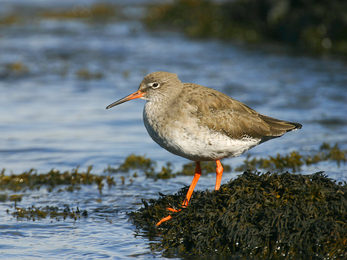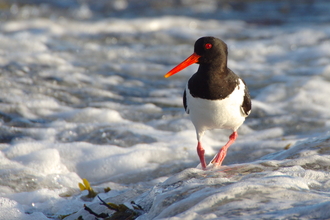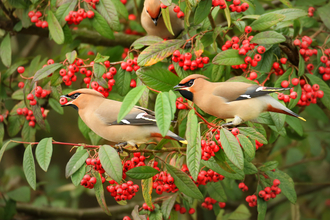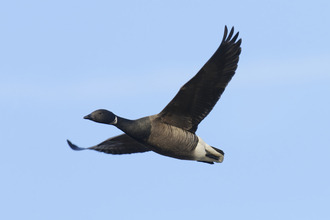Wintering waders
The winter may feel chilly to us, but for waders nesting in the Arctic, the British coast is positively balmy. Every autumn the tundra wastes and taiga boglands empty, and wading birds head for our food-rich estuaries in astounding numbers: Over half a million lapwings from across northern Europe, half a million dunlin from Scandinavia, 300,000 knot from northern Canada, 300,000 oystercatchers from Iceland and Norway, 60,000 bar-tailed godwits from north west Russia, 50,000 Icelandic redshanks, and 40,000 grey plovers from the Arctic join local birds, bickering and jostling for space on our mudflats.
There’s nothing quite like the clamour and swirling patterns of flocks of birds wheeling together as they come in to roost or move from one feeding site to another
Find wintering waders
The Wash, on the east coast between Lincolnshire and Norfolk is one of the most important wetlands on the North Sea, home to upwards of 500,000 birds during the winter. The high tide roost at Gibraltar Point in Lincolnshire regularly attracts more than 100,000 waders, including 80,000 knot as well as oystercatchers, redshank, godwits and dunlin.
North
Cumbria Wildlife Trust
South Walney - On the southern tip of a shingle island at the end of the Furness Peninsula you can see gull colonies in spring, plus breeding oystercatcher, shelduck and eider. Big numbers of migrant wheatear, redstart, willow warbler and goldcrest also gather. In winter, look out for huge numbers of waders and wildfowl.
Northumberland Wildlife Trust
East Chevington - One of four Druridge Bay reserves (including Cresswell Foreshore and Pond, Druridge Pools, and Hauxley – all great for birds). Wigeon, teal, greylag and pink-footed geese over-winter in large numbers, as can 6000-8000 starlings. A great place to watch them gathering in their winter flocks.
The Wildlife Trust for Lancs, Manchester & N Merseyside
Wigan Flashes - The Flashes (lakes) are a legacy of Wigan’s industrial past and were formed as a result of mining subsidence. Over 200 species of bird have been recorded here. Visit for overwintering grey heron, tufted duck, coot, pochard, goldeneye, gadwall and great crested grebe.
Yorkshire Wildlife Trust
Wheldrake Ings - Winter floods attract tens of thousands of wigeon, teal, pintail and mallard, plus Icelandic whooper swans. Large flocks of greylag geese often hold pink-footed and white-fronted geese and the occasional bean goose. Hordes of golden plover and lapwing make an awe-inspiring spectacle when they are buzzed by a hunting peregrine.
Spurn - A curving spit of land, which stretches for three-and-a-half miles across the mouth of the River Humber. Large numbers of wintering and passage waders and wildfowl can be seen, with rarities likely. Great for autumn and spring migration spectacles - in one day 22,000 swallows were recorded and the following day recorders logged 7,000 house martins!
Ripon City Wetlands - Created from the footprint of a working quarry, Ripon City Wetlands nature reserve is a thriving home for a range of birds and other wildlife. You may see bitterns, avocets, little ringed plovers, kingfishers and otters among the reedbeds and in the water. Wander along the marked trail and settle down to watch the wildlife at one of our two viewing places.
North Cave Wetlands - North Cave Wetlands is a true example of a 21st Century nature reserve, developed in the footprint of a large sand and gravel quarry. From spring avocets and common terns, summer dragonflies, to wintering flocks of wildfowl, a day spent here at any time of year will reward.
South
Devon Wildlife Trust
Dawlish Warren - A long spit of sand, which curves like a huge question mark across the mouth of the River Exe towards Exmouth on the opposite bank. It is an arrival and departure point for countless migrant birds including dunlin, ringed plover, curlew and black-tailed godwit amongst many others. As the sea rises the birds edge closer to the hide giving the visitor good close views.
Dorset Wildlife Trust
Brownsea Island - Open via boat from Sandbanks and Poole between April and October, you can expect to see up to 10,000 wading birds close-up. The largest single avocet flock in Britain was recorded here, and in autumn there are regularly up to 2,500 black-tailed godwits, plus curlew, grey plover, dunlin and oystercatcher. National Trust landing charges may apply - see Dorset Wildlife Trust's website for details.
Hampshire and Isle of Wight Wildlife Trust
Blashford Lakes - A series of former gravel pits surrounded by grassland and woodland, the lakes attract large numbers of wildfowl during the winter. Gadwall can number over 900 and there is a roost of up to 65 goosander each evening. Herons, little egret and in recent years great white egret are regular, with bittern seen in some winters. Kingfishers are present all year round.
Farlington Marshes - One of the Trust's oldest reserves and a species-rich grazing marsh of international importance for the waders and wildfowl that it supports, such as bearded tit, sedge and reed warblers. Many flowering plants have also been recorded here, including unusual species such as sea barley and corky-fruited water dropwort.
Somerset Wildlife Trust
Catcott Complex - A great reserve for watching wintering waterfowl and waders. Directly in front of the main hide, internationally important numbers of ducks including wigeon, pintail, shoveler and teal rub up against each other on the flooded fields while waders such as lapwing and snipe pick their way around the drier land. Also watch for Bewick’s swans, golden plover and whimbrel.
Sussex Wildlife Trust
Rye Harbour - Shingle, saltmarsh, sand dunes, rivers, pits, grazing marsh, reedbeds and farmland make this one of the most important conservation sites on the Sussex coast. Always good for birds - 279 species have been recorded here - including large winter flocks of ducks such as smew, and waders.
Wiltshire Wildlife Trust
Langford Lakes - Birds visiting on migration include waders, terns, and osprey which can occasionally be seen in early autumn. Winter is the best time to experience the wildfowl spectacle - many ducks, including tufted duck, pochard, gadwall and great crested grebe use the lakes as wintering grounds. As winter advances shoveler and wigeon add to the growing ranks of species.
Lower Moor Farm - This wetland wonderland is linked by ancient hedges, woods and meadows. Fantastic aerial displays of starlings can be seen around 4pm between December and March as they gather to roost. Watch near the Heronry Hide and also look out for large flocks of redwing, fieldfare, plus teal, goosander, red crested pochard and gadwall.
East
Essex Wildlife Trust
Thurrock Thameside Nature Park - Opened in 2012, this huge, state-of-the-art park has a spectacular hide looking down onto Mucking Flats, used by thousands of dunlin and knot in autumn and winter. Also present in large numbers are other waders, ducks and gulls including bar-tailed godwit, teal, gadwall, pintail and avocet.
Herts and Middlesex Wildlife Trust
Tring Reservoirs - These four spring-fed reservoirs have some of the best birdwatching in southern England: flocks of lapwing, golden plover, goldeneye, wigeon, shoveler, tufted duck, goosander, gadwall and pintail in autumn and winter.
Stocker’s Lake - A large lake in the Colne Valley, which attracts huge numbers of wintering wildfowl including spectacular mandarin ducks as well as shoveler, smew, gadwall, pochard, wigeon and gadwall.
Amwell - This reserve is internationally important on account of the numbers of water birds that visit. In winter there are huge numbers of gadwall and shoveler and also tufted duck, pochard, teal and little grebe. Look out for flocks of lapwing.
Norfolk Wildlife Trust
Cley Marshes was purchased in 1926, making it the first Wildlife Trust reserve in the country. It is one of the best in Europe for birdwatching with many rare visitors. The shingle beach, saline lagoons, grazing marsh and reed bed support large numbers of wintering and migrating wildfowl and waders, as well as bittern, marsh harrier and bearded tit.
Hickling Broad - From October to March the raptor roost at Hickling Broad provides excellent views of raptors as they fly in to roost. You can see hundreds of marsh harriers – a bird which remains rarer than golden eagles as a British breeding species - hen harriers, merlin and barn owl. It is also possibly the best place in Britain to view wild common cranes.
Suffolk Wildlife Trust
Lackford Lakes - A former gravel pit complex by the river Lark, consisting of meadows, woodland, reedbeds and streams. Superb for wildfowl in both winter and summer, Lackford attracts tufted duck, teal, pochard, gadwall, shoveler and goosander. The large winter gull roost can number 28,000.
Carlton Marshes - Extending for 1,000 acres, Carlton Marshes sits in the Waveney Valley at the southern tip of the Norfolk Broads and is part of the Suffolk Broads. It comprises a jigsaw of grazing marsh, fens, peat pools, short fen meadow, tall fen , dykes, pools and scrub. The grazing marshes are ideal for wintering wildfowl with large numbers of wigeon, teal and snipe.
Trimley Marshes - Intended to mitigate the loss of the internationally important Fagbury Mudflats with the expansion of the Port of Felixstowe, a mix of wetland features were sculpted out of former farmland in 1990. Wigeon, teal, Brent geese, redshank and black-tailed godwit are among some of the species you can expect to see with the unmistakable sight of the marsh harrier ghosting over reedbeds almost guaranteed.
Hazlewood Marshes - Formed following a breach in the sea wall, the mudflats and creeks at Hazlewood Marshes are a magnet for wintering birds such as the majestic spoonbill along with huge flocks of black-tailed godwits and dunlin as well as many species of ducks.
Alde Mudflats - Extending for almost three shimmering miles at low water, Alde Mudflats is a vast expanse of inter-tidal mud fringed by a rich band of salt marsh. Avocets and large numbers of curlew, black-tailed godwit, oystercatcher, grey plover, wigeon, pintail, teal and dunlin also use the reserve in winter.
Midlands
Lincolnshire Wildlife Trust
Gibraltar Point - The wader flocks here are one of the wonders of the natural world. Pushed off their feeding and roosting grounds during the highest tides of the year, up to 100,000 knot, dunlin, oystercatcher and sanderling congregate in vast whirling patterns. There are thousands of migrants and winter seabirds too.
Wales
North Wales Wildlife Trust
Cemlyn, Spinnies - A fantastic place to get close to wildlife, where bird hides give you the chance to really spend time with the reserve’s residents. There’s never a dull moment!
Traeth Glaslyn - A stunning place to stop for a while, witnessing the ebb and flow of the tide and the array of life that goes with it.
Radnorshire Wildlife Trust
Llanbwchllyn - From the thatched roof of the bird hide, large flocks of coot can be viewed in winter. There have been occasional sightings of great northern diver and bittern, but more likely sightings are large numbers of tufted duck and goosander as well as rarer birds like gadwall and goldeneye.
Pwllpatti - A bird hide overlooking an old ox-bow of the River Wye which floods in winter. It is home to the largest wigeon roost in Powys and also a good place for teal. Species also likely to be seen are common sandpiper, redshank, oystercatcher, little egret, tufted duck and mallard.
Scotland
Scottish Wildlife Trust
Montrose Basin - Tidal basin with mud, fresh and salt water, saltmarsh, reedbed and grassland. Pink-footed geese peak gather in November and number around 20,000-40,000. There are also usually about 2,000 overwintering redshank and eider, 3,000 wigeon, 4,000 oystercatchers and perhaps even more knot.
Northern Ireland
Ulster Wildlife Trust)
Isle of Muck - This impressive island nature reserve, off Islandmagee in Co. Antrim, contains the third largest colony of cliff-nesting seabirds in Northern Ireland. Kittiwake, guillemot, fulmar and razorbill all breed here in large numbers and there’s a chance of spotting puffin, peregrine, otter and cetaceans on a visit.
The Channel Islands
Alderney Wildlife Trust
Les Etacs and Ortac - Alderney is a haven for seabirds as well as a hotspot for migrating birds in spring and autumn. The spectacular Les Etacs and Ortac rocks support more than 2% of the world’s northern gannet population. These colonies are some of the most southerly found within the gannet’s range, with over 7,000 breeding pairs recorded.
How to do it
Time your visit for an hour or so before high tide, and you'll be there to see the birds pushed up off the mud by the incoming water. At high tide roost sites, thousands of birds gather together, jostling for space on what remains of the higher ground. The spring tides are the highest of the year, so will normally result in the biggest performances by the flocks.
If you can't get to these places
The UK combines the ideal location for wading birds: on the western edge of Europe, bathed by the warm Gulf Stream, together with wetlands and coastal muds that are extremely rich in invertebrate life. The largest numbers can be seen on the big sheltered estuaries, places like the estuaries of the Severn, Humber, Solent, Dee, Mersey, Thames estuary and especially the Wash. Head to one of those and you are bound to have a wader-filled day!
More wildlife experiences
From seeing colourful wildflowers to spotting magnificent birds of prey, we can help you get closer to wildlife across the UK.









